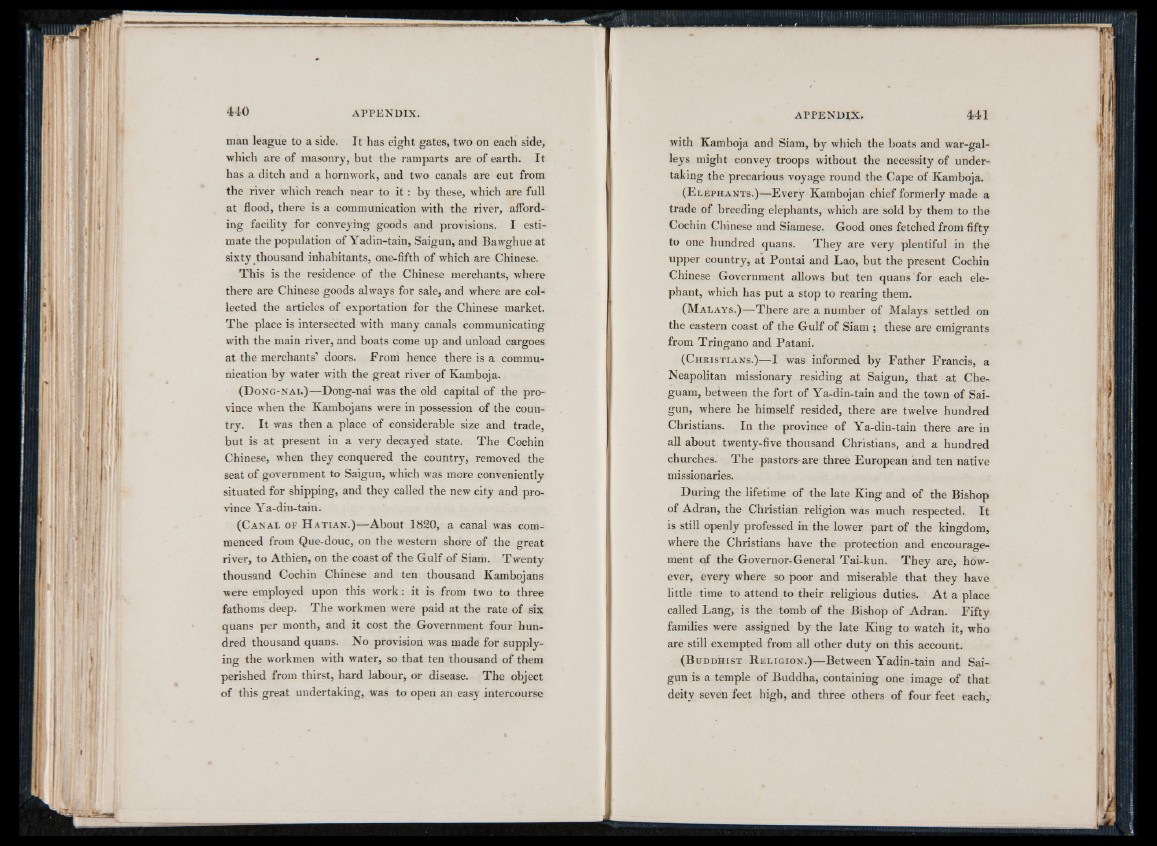
man league to a side. It has eight gates, two on each side,
which are o f masonry, but the ramparts are o f earth. It
has a ditch and a hornwork, and two canals are cut from
the river which reach near to i t : by these, which are full
at flood, there is a communication with the river, affording
facility for conveying goods and provisions. I estimate
the population of Yadin-tain, Saigun, and Bawghue at
sixty thousand inhabitants, one-fifth of which are Chinese.
This is the residence of the Chinese merchants, where
there are Chinese goods always for sale, and where are collected
the articles o f exportation for the Chinese market.
Th e place is intersected with many canals communicating
with the main river, and boats come up and unload cargoes
at the merchants’ doors. Prom hence there is a communication
by water with the great river o f Kamboja.
( D o n g - n a i . ) —Dong-nai was the old capital o f the province
when the Kambojans were in possession of the country.
I t was then a place o f considerable size and trade,
but is at present in a very decayed state. The Cochin
Chinese, when they conquered the country, removed the
seat o f government to Saigun, which was more conveniently
situated for shipping, and they called the new city and province
Ya-diu-tain.
( C a n a l o f H a t i a n . ) —About 1820, a canal was commenced
from Que-douc, on the western shore of the great
river, to Athien, on the coast of the Gulf o f Siam. Twenty
thousand Cochin Chinese and ten thousand Kambojans
were employed upon this work: it is from two to three
fathoms deep. Th e workmen were paid at the rate of six
quans per month, and it cost the Government four hundred
thousand quans. N o provision was made for supplying
the workmen with water, so that ten thousand o f them
perished from thirst, hard labour, or disease. The object
o f this great undertaking, was to open an easy intercourse
with Kamboja and Siam, by which the boats and war-gal-
leys might convey troops without the necessity of undertaking
the precarious voyage round the Cape of Kamboja.
( E l e p h a n t s . ) —Every Kambojan chief formerly made a
trade o f breeding elephants, which are sold by them to the
Cochin Chinese and Siamese. Good ones fetched from fifty
to one hundred quans. They are very plentiful in the
upper country, at Pontai and Lao, but the present Cochin
Chinese Government allows but ten quans for each elephant,
which has put a stop to rearing them.
( M a l a y s . ) — There are a number o f Malays settled on
the eastern coast of the Gulf o f Siam ; these are emigrants
from Tringano and Patani.
( C h r i s t i a n s . )—I was informed by Father Francis, a
Neapolitan missionary residing at Saigun, that at Che-
guam, between the fort o f Ya-din-tain and the town o f Saigun,
where he himself resided, there are twelve hundred
Christians. In the province o f Ya-din-tain there are in
all about twenty-five thousand Christians, and a hundred
churches. The pastors-are three European iand ten native
missionaries.
During the lifetime o f the late King and o f the Bishop
of Adran, the Christian religion was much respected. I t
is still openly professed in the lower part o f the kingdom,
where the Christians have the protection and encouragement
o f the Governor-General Tai-kun. T h ey are, however,
every where so poor and miserable that they have
little time to attend to their religious duties. A t a place
called Lang, is the tomb o f the Bishop o f Adran. F ifty
families were assigned by the late King to watch it, who
are still exempted from all other duty on this account.
( B u d d h i s t R e l i g i o n . ) —Between Yadin-tain and Saigun
is a temple o f Buddha, containing one image o f that
deity seven feet high, and three others o f four feet each,